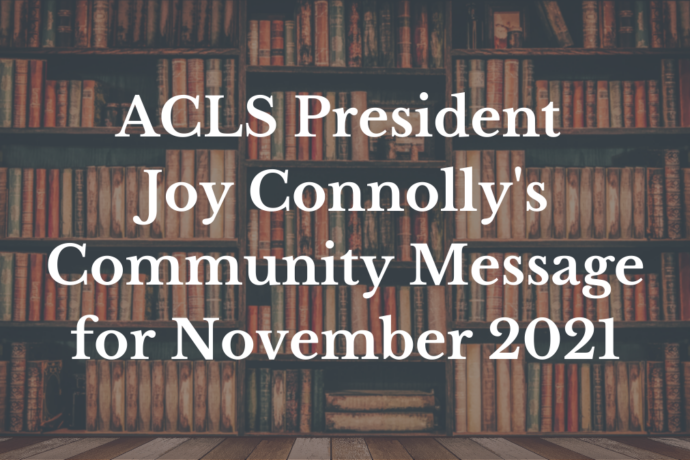ACLS Community Message for November 2021

This past week I flew to the Charleston Conference, a gathering of librarians, publishers, and consultants: my first in-person conference in eighteen months. I’m grateful to the van driver who got me and three fellow travelers to our hotels in record time – very welcome at 2 AM after a long-delayed flight – giving us an affable introduction to the city as he drove.
The issue I went to the conference to discuss at a plenary session was this: at a time when more people have greater access to more knowledge than ever before, scholarship at many of the most well-resourced and influential colleges and universities has become more highly specialized. As I said last April, I hope the pandemic’s exposure of pressures on faculty fosters a more flexible approach to defining what counts in the production and circulation of knowledge, so that we welcome and reward work that appears in a variety of formats and that speaks to a variety of audiences.
This is a matter of diversity, equity, and inclusion. In their preface to the 2008 Julie Ellison and Timothy K. Eatman report, “Scholarship in Public,” Nancy Cantor, then chancellor and president of Syracuse University, now Chancellor of Rutgers University-Newark; and Steven Lavine, then president of the California Institute of the Arts, drew attention to the close connection between supporting a wide spectrum of what counts as scholarship and retaining a diverse faculty and graduate student population. “Many faculty members,” they wrote, “experience a frustrating clash between their intellectual goals, which include pursuing community-based scholarship and art-making, and institutional tenure policies.”
How can libraries and publishers, particularly at university presses, contribute to the conversation that many research universities and selective liberal arts colleges are having about scholarship – specifically, how we might broaden scholarship’s scope, form, and impact?
I chose the title of my talk, “Think Different,” with intentional reference to the famous Apple ad of 1997. It featured shots of Gandhi, Martin Luther King, Amelia Earhart, and Alfred Hitchcock, among others. Those of my generation may remember the text: “Here’s to the crazy ones. The misfits. The rebels. The troublemakers. The round pegs in the square holes. The ones who see things differently. They’re not fond of rules. And they have no respect for the status quo. You can quote them, disagree with them, glorify or vilify them. About the only thing you can’t do is ignore them. Because they change things. They push the human race forward. While some may see them as the crazy ones, we see genius. Because the people who are crazy enough to think they can change the world, are the ones who do.”
I suspect I’m not alone in having originally been drawn to academia partly because I saw it as a haven for “the crazy ones,” the ones who see things differently, who try to push the human race forward, who don’t fit into conventional culture, office or otherwise, who love to dive into ideas and to get new thinking into circulation. But that forging of challenging ideas is only one of the modes of the university, as Emily Levine shows in her recent book Allies and Rivals: German-American Exchange and the Rise of the Modern Research University. She reminds us that American universities have always danced to traditional tunes even as they served as beacons for the creative and the radical. The university exists in a constant struggle between experimentation (in both research and teaching) and the fight for reputation and tuition, between agitation for social change and climbing the rankings in the game of elite credentialism. In such an environment, change is never simple.
In Charleston, I offered three exploratory suggestions for how librarians and publishers might help shape and amplify the exciting work in the humanities and interpretive social sciences that break the mold of traditional, specialized, and almost exclusively solitary scholarship:
1) People no longer think of libraries as the only place to go for knowledge; they look to their computers and devices for that. But libraries have experts, large buildings on campus, and sophisticated virtual spaces that can help connect people – including academics and people outside academia – in centralized, organized ways that would prevent individual faculty from re-inventing the wheel when they begin to think different.
2) Libraries and presses can join in the effort to develop forms and resources for digital, public-facing, and collaborative scholarship, including metrics of progress, so that we can expand – not abolish, but expand – the “book for tenure” model common in many humanities and interpretive social science departments at most research universities.
3) They can work on the problem of unequal access to scholarship by exploring models in which greater (and perhaps open) access can be reconciled with the real costs of disseminating knowledge. Efforts like “subscribe to open” books sketch out how balanced approaches may be feasible. Here, ACLS is eager to learn more and to help others learn more.
Many of them are doing these things already, so a fourth point is how to make their efforts more visible.
The conference was energizing and exciting – how wonderful it is to see people again in three dimensions! It reminded me of the importance of meeting together in person and the ongoing challenge of providing equitable access to in-person meetings as well as hybrid options for those who cannot or do not wish to travel. I thank Professor James O’Donnell of Arizona State University and his fellow organizers for inviting me. And I look forward to further discussion with our colleagues in libraries and presses.
Sign up for the monthly ACLS Community Newsletter, as well as announcements and updates about programs, events, and more.

